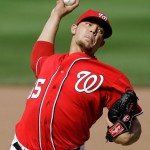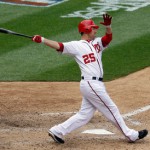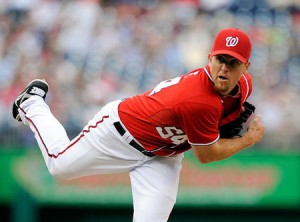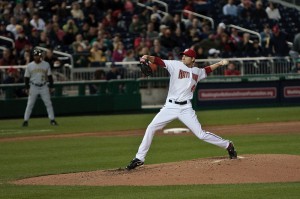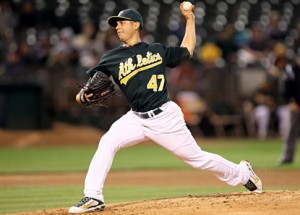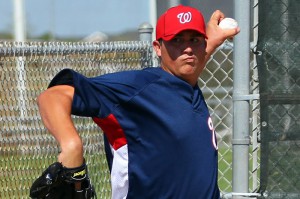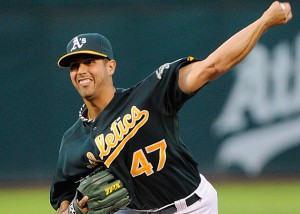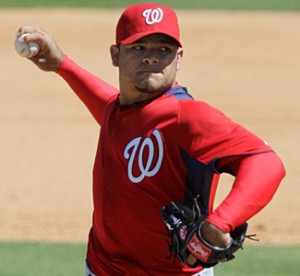After finishing the evaluation of all 6 minor league pitching staffs, plus finally finishing (and posting yesterday) the MLB season review, here’s an entirely too-early projection of what the staffs and rotations may look like in 2013. This post assumes for the time being that all major and minor league FAs will opt out and we’ll be looking to fill spots. In these cases I’ll mark FAs to be as needed, though we very well may acquire these players in trade.
Note: some of these projections are slightly different from the original reviews posted in the per-level links, to account for moves, performances and roster moves that have already happened or seem set to happen this off-season. I’ve also made some slight adjustments in order to make the rotations and bullpens work at each level.
(notations: FA = free agent, MLFA == Minor League Free Agent)
Staff Review links: MLB is here, AAA is here, AA is here, High-A is here, Low-A is here, Short-A is here, GCL is here.
- MLB Rotation: Strasburg, Gonzalez, Zimmermann, Detwiler, FA or other acquisition
- MLB Bullpen: Clippard, Storen, Mattheus, Stammen, Garcia, a FA left-hander (possibly Burnett), a FA long-man (possibly Gorzelanny).
- MLB notables Out of Organization: Jackson, Burnett, Gonzalez, Lannan, Wang
MLB Narrative: 4/5ths of the rotation are no-brainers. The 5th starter is the question mark for 2013. Do we re-sign Jackson and pay him more as a 5th starter than our big 3 guys? It doesn’t seem so after the team declined to give him a Qualifying Offer. Do we trade from depth (RH relief, middle infield) and find a 5th starter that way? Do we find a 5th starter from within? Meanwhile the bullpen is now full of hard throwing righties, but we could lose all 3 of our lefties. We may need to work the phones to retain these guys, or else we’re on the FA market. I think (despite my discussion about converting Garcia to a 5th starter) that he’ll remain in the bullpen and may bump Henry Rodriguez out of a job. One of our two closer-quality guys (Clippard and Storen) could be moved, cashing in on their value, which could open up a spot for a FA acquisition or a promotion from AAA.
Lots to be decided this off-season for Mike Rizzo, and this hasn’t even mentioned the dominos that will fall if/when the team makes a contract decision on Adam LaRoche.
- AAA Rotation: Roark, Maya, Broderick, Meyers, Perry
- AAA Bullpen: Tatusko (swingman), Arneson (swingman), Severino (loogy), Davis, Lehman, Nelo (closer), Martin, Mandel
AAA Narrative: We have a lot of long-serving minor leaguers here; as it stands now only a few of them are even 40-man roster guys (Maya, Perry, Garcia). The modern AAA roster construction is one of “spare parts” and prospects; do we have enough prospects to cover for injuries at the MLB level? Which one of these AAA starters would Nats fans feel comfortable filling in were one of our starters to go down with injury? Perhaps the Nats need to work on some starter depth via trade. Brad Meyers was just returned from the Yankees after a season-long DL stint after being Rule-5 drafted, and seems likely to slot right back into the AAA rotation when he’s healthy. Perry seems set to get a 4th option and should slot in here, looking to convert back to being a starter. Broderick is a former Rule-5 pick and was claimed from St. Louis, who dumped him late last season. I don’t think he’s anything more than a 4-A starter, but the organization seems to like him.
- AA Rotation: Rosenbaum, Holder, Gilliam, Karns, Grace, Demny (swingman?) or MLFA? Solis if he’s healthy?
- AA Bullpen: Frias, McCoy, Selik (maybe high-A again), Holland (setup), Wort (closer), VanAllen (loogy), Demmin (maybe high-A again), an org arm or two to fill in.
AA narrative: We have a couple of interesting candidates in the AA rotation to start, but what may be more interesting is to see whether the likes of Gilliam and Demny hold onto their spots with the talent ready to rise up out of high-A. Meanwhile, the bullpen has some interesting arms to keep an eye on. I forgot to mention Solis in the AA write-up but remembered him here. Two big questions for me in this AA rotation for 2013: 1) is Rosenbaum for real or is he going to sputter out before reaching MLB potential? And, 2) Is Nathan Karns ready to make the leap? I think Karns can quickly put his name in the mix to get promoted to AAA based on his performance in 2012.
- High-A Rotation: Swynenberg, Ray, Meyer (maybe AA?), Schwartz (maybe low-A), Rauh (maybe low-A)
- High-A Bullpen Competition: Barrett (maybe AA) , Testa, Smoker (loogy), Hill, Meza (perhaps a starter?), Holt, Hawkins, Bates, Mirowski
- High-A bullpen Release candidates: Olbrychowski, McCatty, Applebee
High-A narrative: there’s too many arms for too few slots right now in all three of the A-levels. There’s a ton of release candidates, and some guys who could be higher or lower. I’d love to be a fly on the wall at the organizational meetings where all this evaluation is done. Meyer dominated High-A last year; could he start in AA? Barrett (by virtue of his AFL appearance) may also be AA material.
The same goes for the Low-A team below: I’ve got 5 logical rotation candidates, another 4 guys who make sense to be in the low-A rotation, and a slew of guys who seem to have earned their way to the low-A bullpen. But there’s only 7 slots to go around.
- Low-A Rotation: Turnbull, Jordan, Purke (if healthy), Monar, Mooneyham
- Low-A Rotation Competitors: Hansen, Lee (loogy if not), Encarnation, McGeary (if finally healthy)
- Low-A Bullpen Competition: Anderson, Estevez, Dupra, McKenzie, Henke, Davis, Boyden, Benincasa, Hudgins, Dicherry, Mudron
We acknowledge the folly of trying to predict short-season staffs which will mostly be populated with 2013 draftees, especially under the new CBA that shortens negotiation times, making it more likely college seniors are drafted (who sign quickly with zero leverage) and get playing. That being said, there will definitely be guys who stay in extended spring training for a couple months and then get placed on these rosters along with new draftees. Here’s some guesses based on 2012 performances; all blank spots filled by 2013 draftees or by some of the guys who drop down from low-A.
- Short-A Rotation: Baez, Pineyro
- Short-A Bullpen: Smith (if not released), Fischer, Medina, Pena, Mendez
GCL blank spots filled by younger 2013 draftees (HS, Juco and college juniors/seniors from smaller schools) and by rising DSL grads.
- GCL Rotation: Mieses (if not released), Barrientos, Vasquez
- GCL Bullpen: Heredes

